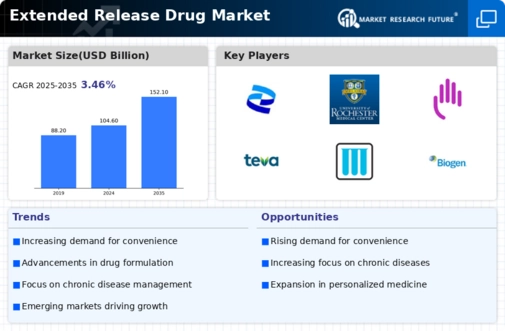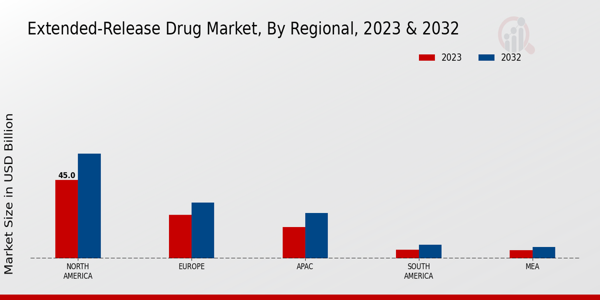Increasing Geriatric Population
The aging population worldwide is a critical driver for the Global Extended Release Drug Market Industry. As individuals age, they often experience multiple health issues that necessitate complex medication regimens. Extended release formulations simplify these regimens by reducing the frequency of dosing, which is particularly beneficial for elderly patients who may struggle with adherence. According to the United Nations, the global population aged 65 and older is expected to reach 1.5 billion by 2050. This demographic shift is anticipated to create a robust demand for extended release medications, thereby propelling market growth.
Rising Prevalence of Chronic Diseases
The Global Extended Release Drug Market Industry is experiencing growth due to the increasing prevalence of chronic diseases such as diabetes, hypertension, and cardiovascular disorders. As these conditions require long-term management, extended release formulations provide a convenient dosing schedule that enhances patient adherence. For instance, the World Health Organization indicates that chronic diseases account for approximately 71 percent of all deaths globally. This trend is expected to drive the demand for extended release medications, contributing to the market's projected value of 104.6 USD Billion in 2024 and a further increase to 152.1 USD Billion by 2035.
Advancements in Drug Delivery Technologies
Innovations in drug delivery systems are significantly influencing the Global Extended Release Drug Market Industry. Technologies such as nanotechnology, polymer-based systems, and microencapsulation are enhancing the efficacy and safety of extended release formulations. These advancements allow for more precise control over drug release rates, which can lead to improved therapeutic outcomes. For example, the development of biodegradable polymers has enabled the creation of extended release drugs that minimize side effects while maximizing patient compliance. This technological evolution is likely to support the market's growth, with a projected CAGR of 3.46 percent from 2025 to 2035.
Growing Focus on Patient-Centric Healthcare
There is a notable shift towards patient-centric healthcare models, which is positively impacting the Global Extended Release Drug Market Industry. Healthcare providers are increasingly prioritizing patient outcomes and satisfaction, leading to a preference for medications that enhance adherence and minimize side effects. Extended release drugs align with this focus by providing stable therapeutic levels over extended periods, reducing the need for frequent dosing. This trend is further supported by healthcare policies that emphasize value-based care, which may drive the adoption of extended release formulations in clinical practice.
Regulatory Support for Extended Release Formulations
Regulatory bodies are increasingly recognizing the benefits of extended release formulations, which is fostering growth in the Global Extended Release Drug Market Industry. Agencies such as the Food and Drug Administration are providing clearer guidelines for the development and approval of these drugs, facilitating innovation and market entry. This supportive regulatory environment encourages pharmaceutical companies to invest in research and development of extended release products, which can lead to a broader range of therapeutic options for patients. As a result, the market is likely to see an influx of new products, enhancing competition and driving growth.
























Leave a Comment